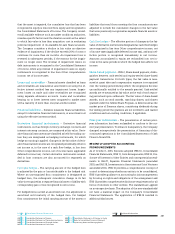Siemens 2014 Annual Report Download - page 263
Download and view the complete annual report
Please find page 263 of the 2014 Siemens annual report below. You can navigate through the pages in the report by either clicking on the pages listed below, or by using the keyword search tool below to find specific information within the annual report.
247 D. Consolidated Financial Statements 337 E. Additional Information
248 D. Consolidated Statements of Income
249 D. Consolidated Statements of Comprehensive Income
250 D. Consolidated Statements of Financial Position
251 D. Consolidated Statements of Cash Flows
252 D. Consolidated Statements of Changes in Equity
254 D. Notes to Consolidated Financial Statements
330 D. Supervisory Board and Managing Board
resulting in a decrease of revenue in the respective reporting
period. Management of the operating Divisions continually
reviews all estimates involved in such construction contracts
and adjusts them as necessary.
Trade and other receivables – The allowance for doubtful
accounts involves significant management judgment and
review of individual receivables based on individual customer
creditworthiness, current economic trends and analysis of
historical bad debts on a portfolio basis. For the determination
of the country-specific component of the individual allowance,
Siemens also consider country credit ratings, which are cen-
trally determined based on information from external rating
agencies. Regarding the determination of the valuation allow-
ance derived from a portfolio-based analysis of historical bad
debts, a decline of receivables in volume results in a corre-
sponding reduction of such provisions and vice versa. As of
September , and , Siemens recorded a total valua-
tion allowance for trade and other receivables of € , million
and € , million, respectively.
Impairment – Siemens tests at least annually whether good-
will has incurred any impairment, in accordance with its
accounting policy. The determination of the recoverable
amount of a cash-generating unit or a group of cash-generat-
ing units to which goodwill is allocated involves the use of
estimates by management. The outcome predicted by these
estimates is influenced e.g. by the successful integration of
acquired entities, volatility of capital markets, interest rate
developments, foreign exchange rate fluctuations and the
outlook on economic trends. The recoverable amount is the
higher of the cash-generating unit’s or the group of cash-
generating units’ fair value less costs to sell and its value in
use. The Company generally uses discounted cash flow based
methods to determine these values. These discounted cash
flow calculations use five-year projections that are based on
financial forecasts. Cash flow projections take into account
past experience and represent management’s best estimate
about future developments. Cash flows after the planning
period are extrapolated using individual growth rates. Key
assumptions on which management has based its determina-
tion of fair value less costs to sell and value in use include
estimated growth rates, weighted average cost of capital and
tax rates. These estimates, including the methodology used,
can have a material impact on the respective values and ulti-
mately the amount of any goodwill impairment. Likewise,
whenever property, plant and equipment, other intangible
assets and investments accounted for using the equity method
are tested for impairment, the determination of the assets’
recoverable amount involves the use of estimates by manage-
ment that can have a material impact on the respective values
and ultimately the amount of any impairment.
Non-current assets and disposal groups classified as
held for disposal – Assets held for disposal and disposal
groups are measured at the lower of their carrying amount
and their fair value less costs to sell. The determination of the
fair value less costs to sell includes the use of management
estimates and assumptions that tend to be uncertain.
Employee benefit accounting – Post-employment benefits –
Obligations for pension and other post-employment bene fits
and related net periodic benefit costs are determined in accor-
dance with actuarial valuations. These valuations rely on key
assumptions including discount rates, expected compensation
increases, rate of pension progression and mortality rates. The
discount rate assumptions are determined by reference to
yields on high-quality corporate bonds of appropriate duration
and currency at the end of the reporting period. In case such
yields are not available discount rates are based on govern-
ment bonds yields. Due to changing market, economic and
social conditions the underlying key assumptions may differ
from actual developments and may lead to significant changes
in pension and other post-employment benefit obligations.
Such differences are recognized in full through line item Other
comprehensive income, net of income taxes in the period in
which they occur without affecting profit or loss.
Provisions – Significant estimates are involved in the determi-
nation of provisions related to onerous contracts, warranty
costs, asset retirement obligations and legal proceedings.
A significant portion of the business of certain operating divi-
sions is performed pursuant to long-term contracts, often for
large projects, in Germany and abroad, awarded on a competi-
tive bidding basis. Siemens records a provision for onerous
sales contracts when current estimates of total contract costs
exceed expected contract revenue. Such estimates are subject
to change based on new information as projects progress to-
wards completion. Onerous sales contracts are identified by
monitoring the progress of the project and updating the esti-
mate of total contract costs which also requires significant
judgment relating to achieving certain performance standards
as well as estimates involving warranty costs and estimates
regarding project delays including the assessment of respon-
sibility splits between the contract partners for these delays.
Significant estimates and assumptions are also involved in the
determination of provisions related to major asset retirement
obligations. Uncertainties surrounding the amount to be rec-
ognized include, for example, the estimated costs of decom-
missioning because of the long time frame over which future
cash outflows are expected to occur including the respective
interest accretion. Amongst others, the estimated cash out-
flows could alter significantly if, and when, political develop-
ments affect the government’s plans to develop the final
storage.
























